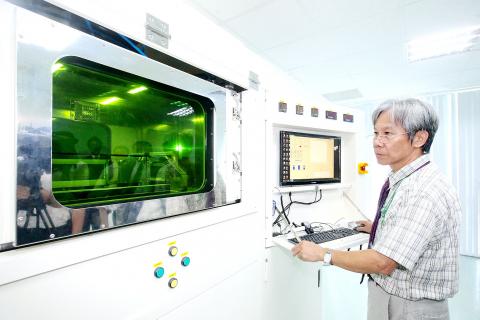National Chung-Shan Institute of Science and Technology (CSIST, 國家中山科學研究院) yesterday demonstrated Taiwan’s first indigenously developed metal 3D printing system, saying that it hopes to see the technology used in the aerospace and defense industries.
CSIST said it began to develop the system at its research park in Taoyuan last year with help from the Ministry of Economic Affairs and the Ministry of National Defense.
Missile and Rocket Systems Research Division deputy general director Jen Kuo-kang (任國光) said that 3D printing, also known as additive manufacturing (AM), can break through the limits of traditional manufacturing processes and be used in a wide range of areas.

Photo: CNA
The institute, which is the nation’s main weapons research and development center, has developed a 250mm x 250mm metal AM system, which Jen said “can satisfy the needs of the aerospace and defense industries.”
The system can help speed up the manufacturing process of metal components and produce products of better quality, he told reporters during a media tour of the research park.
The system would make it possible to manufacture parts for aging military equipment whose original manufacturers have ceased production, Jen said.
Asked if the system could be used to produce components for submarines, Jen said it could.
After the exact material of a component is identified, the institute’s staff would be able to make the same item using the system, he added.
The institute is working with National Cheng Kung University in the production of powder materials, the basic element for metal 3D printing, he said.
“We hope this goal will be achieved in six months,” he added.

UNCERTAINTY: Innolux activated a stringent supply chain management mechanism, as it did during the COVID-19 pandemic, to ensure optimal inventory levels for customers Flat-panel display makers AUO Corp (友達) and Innolux Corp (群創) yesterday said that about 12 to 20 percent of their display business is at risk of potential US tariffs and that they would relocate production or shipment destinations to mitigate the levies’ effects. US tariffs would have a direct impact of US$200 million on AUO’s revenue, company chairman Paul Peng (彭雙浪) told reporters on the sidelines of the Touch Taiwan trade show in Taipei yesterday. That would make up about 12 percent of the company’s overall revenue. To cope with the tariff uncertainty, AUO plans to allocate its production to manufacturing facilities in

TAKING STOCK: A Taiwanese cookware firm in Vietnam urged customers to assess inventory or place orders early so shipments can reach the US while tariffs are paused Taiwanese businesses in Vietnam are exploring alternatives after the White House imposed a 46 percent import duty on Vietnamese goods, following US President Donald Trump’s announcement of “reciprocal” tariffs on the US’ trading partners. Lo Shih-liang (羅世良), chairman of Brico Industry Co (裕茂工業), a Taiwanese company that manufactures cast iron cookware and stove components in Vietnam, said that more than 40 percent of his business was tied to the US market, describing the constant US policy shifts as an emotional roller coaster. “I work during the day and stay up all night watching the news. I’ve been following US news until 3am

COLLABORATION: Given Taiwan’s key position in global supply chains, the US firm is discussing strategies with local partners and clients to deal with global uncertainties Advanced Micro Devices Inc (AMD) yesterday said it is meeting with local ecosystem partners, including Taiwan Semiconductor Manufacturing Co (TSMC, 台積電), to discuss strategies, including long-term manufacturing, to navigate uncertainties such as US tariffs, as Taiwan occupies an important position in global supply chains. AMD chief executive officer Lisa Su (蘇姿丰) told reporters that Taiwan is an important part of the chip designer’s ecosystem and she is discussing with partners and customers in Taiwan to forge strong collaborations on different areas during this critical period. AMD has just become the first artificial-intelligence (AI) server chip customer of TSMC to utilize its advanced

Six years ago, LVMH’s billionaire CEO Bernard Arnault and US President Donald Trump cut the blue ribbon on a factory in rural Texas that would make designer handbags for Louis Vuitton, one of the world’s best-known luxury brands. However, since the high-profile opening, the factory has faced a host of problems limiting production, 11 former Louis Vuitton employees said. The site has consistently ranked among the worst-performing for Louis Vuitton globally, “significantly” underperforming other facilities, said three former Louis Vuitton workers and a senior industry source, who cited internal rankings shared with staff. The plant’s problems — which have not